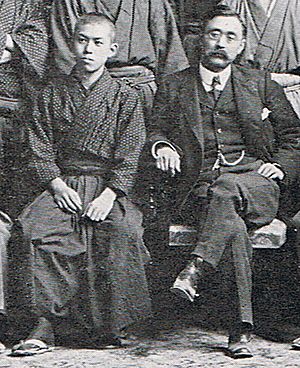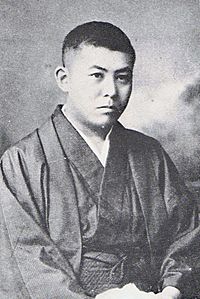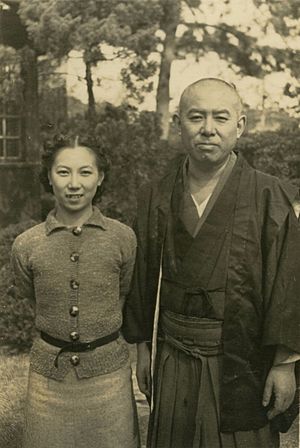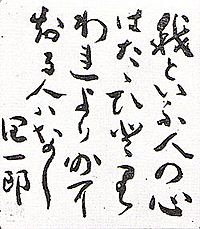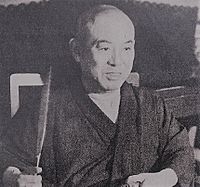Jun'ichirō Tanizaki facts for kids
Quick facts for kids
Tanizaki Jun'ichirō
|
|
|---|---|

Tanizaki in 1951
|
|
| Native name |
谷崎 潤一郎
|
| Born | 24 July 1886 Nihonbashi, Tokyo, Empire of Japan |
| Died | 30 July 1965 (aged 79) Yugawara, Kanagawa, Japan |
| Occupation | Writer |
| Genre | Fiction, drama, essays, silent film scenarios |
| Spouse |
|
| Children | 2 |
Jun'ichirō Tanizaki (谷崎 潤一郎, Tanizaki Jun'ichirō, 24 July 1886 – 30 July 1965) was a Japanese author who is considered to be one of the most prominent figures in modern Japanese literature.
He was one of six authors on the final shortlist for the Nobel Prize in Literature in 1964, the year before his death.
Biography
Early life
Tanizaki was born into a well-to-do merchant class family in Nihonbashi, Tokyo, where his uncle owned a printing press, which had been established by his grandfather. His parents were Kuragorō and Seki Tanizaki. His older brother, Kumakichi, died three days after his birth, which made him the next eldest son of the family. Tanizaki had three younger brothers: Tokuzō, Seiji (also a writer) and Shūhei, as well three younger sisters: Sono, Ise and Sue. Tanizaki described his admittedly pampered childhood in his Yōshō Jidai (Childhood Years, 1956). His childhood home was destroyed in the 1894 Meiji Tokyo earthquake, to which Tanizaki later attributed his lifelong fear of earthquakes. His family's finances declined dramatically as he grew older until he was forced to reside in another household as a tutor.
Despite these financial problems, he attended the Tokyo First Middle School, where he became acquainted with Isamu Yoshii. Tanizaki attended the Literature Department of Tokyo Imperial University from 1908, but was forced to drop out in 1911 because of his inability to pay for tuition.
Early literary career
Tanizaki began his literary career in 1909. His first work, a one-act stage play, was published in a literary magazine that he had helped found. Tanizaki's name first became widely known with the publication of the short story Shisei (The Tattooer, 1910). Tanizaki's other works published in the Taishō period include Shindo (1916) and Oni no men (1916), which are partly autobiographical.
Tanizaki married his first wife, Chiyo Ishikawa, in 1915, and his only child, Ayuko, was born in 1916. However, it was an unhappy marriage, and in time he encouraged a relationship between Chiyo and his friend and fellow writer Haruo Satō. The psychological stress of this situation is reflected in some of his early works, including the stage play Aisureba koso (Because I Love Her, 1921) and the novel Kami to hito no aida (Between Men and the Gods, 1924). Even though some of Tanizaki's writings seem to have been inspired by these and other persons and events in his life, his works are far less autobiographical than those of most of his contemporaries in Japan. Tanizaki later adopted Emiko, the daughter of his third wife, Matsuko Morita.
In 1918, Tanizaki toured Chōsen, northern China, and Manchuria. In his early years he became infatuated with the West and all things modern. In 1922, he relocated from Odawara, where he had been living since 1919, to Yokohama, which had a large expatriate population, living briefly in a Western-style house and leading a bohemian lifestyle. This outlook is reflected in some of his early writings.
Tanizaki had a brief career in silent cinema, working as a script writer for the Taikatsu film studio. He was a supporter of the Pure Film Movement and was instrumental in bringing modernist themes to Japanese film. Some have argued that Tanizaki's relation to cinema is important to understanding his overall career.
Period in Kyoto
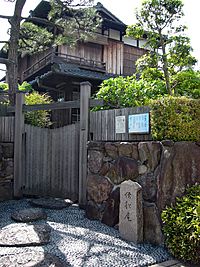
Tanizaki's reputation began to take off in 1923, when he moved to Kyoto after the Great Kanto earthquake, which destroyed his house in Yokohama (at the time Tanizaki was on a bus in Hakone and thus escaped injury). The loss of Tokyo's historic buildings and neighborhoods in the quake triggered a change in his enthusiasms, as he redirected his youthful love for the imagined West and modernity into a renewed interest in Japanese aesthetics and culture, particularly the culture of the Kansai region (around the cities of Osaka, Kobe and Kyoto). His first novel after the earthquake, and his first truly successful novel, was Chijin no ai (Naomi, 1924-25). Tanizaki made another trip to China in 1926, where he met Guo Moruo, with whom he later maintained correspondence. He relocated from Kyoto to Kobe in 1928.
His renewed interest in classical Japanese literature culminated in his multiple translations into modern Japanese of the eleventh-century classic The Tale of Genji and in his masterpiece Sasameyuki (literally "A Light Snowfall," but published in English translation as The Makioka Sisters, 1943–1948), a detailed characterization of four daughters of a wealthy Osaka merchant family who see their way of life slipping away in the early years of World War II. The sisters live a cosmopolitan life with European neighbors and friends, without suffering the cultural-identity crises common to earlier Tanizaki characters. When he began to serialize the novel, the editors of the literary magazine Chūō Kōron were warned that it did not contribute to the needed war spirit and, fearful of losing supplies of paper, cut off the serialization.
Tanizaki relocated to the resort town of Atami, Shizuoka in 1942, but returned to Kyoto in 1946.
Post-war period
After World War II, Tanizaki again emerged into literary prominence, winning a host of awards. Until his death, he was widely regarded as Japan's greatest contemporary author. He won the prestigious Asahi Prize in 1948, was awarded the Order of Culture by the Japanese government in 1949, and in 1964 was elected to honorary membership in the American Academy and Institute of Arts and Letters, the first Japanese writer to be so honoured.
Legacy
The Tanizaki Prize is one of Japan's most sought-after literary awards. Established in 1965 by the publishing company Chūō Kōronsha, it is awarded annually to a work of fiction or drama.
Before Haruki Murakami had achieved wide renown, Tanizaki was frequently considered one of the "Big Three" postwar Japanese writers along with Yasunari Kawabata and Yukio Mishima.
See also
 In Spanish: Jun'ichirō Tanizaki para niños
In Spanish: Jun'ichirō Tanizaki para niños


